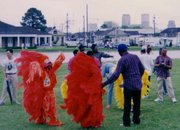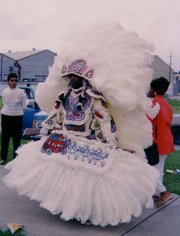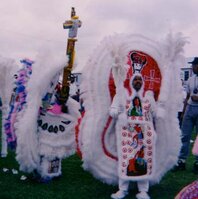Mardi Gras Indians
|
|
Mardi Gras Indians are mostly African-American Carnival revelers in New Orleans, Louisiana. Collectively, their krewes (organizations) are called "tribes". They dress up in costumes influenced by Native American ceremonial apparel for Mardi Gras. Many of the tribes also parade on the Sunday nearest to Saint Joseph's Day, and sometimes the New Orleans Jazz & Heritage Festival. Traditionally the tribes were male only, but in the late 20th century female "Indians" began appearing as well. Today, there are around 34 tribes. They can range in size from a half dozen to several dozen members. The tribes are largely independent, but a pair of umbrella organizations loosely coordinate the Uptown Indians and the Downtown Indians.
| Contents |
History
Mardi Gras Indians have been parading in New Orleans at least since the mid 19th century, possibly before. The tradition was said to have originated from an affinity between Africans and Indians as fellow outcasts of society, and blacks circumventing some of the worst racial segregation laws by representing themselves as Indians. An appearance in town of Buffalo Bill's Wild West Show in the 1880s was said to have drawn considerable attention and increased the interest in masking as Indians for Mardi Gras. Then, when Caribbean communities started to spring up in New Orleans, their culture was incorporated into the costumes, dances and music made by the "Indians".
In the late 19th century and early years of the 20th century the tribes had a reputation for violent fights with each other. This part of Mardi Gras Indian history is immortalized in James Sugar Boy Crawford's Jock O Mo (better known and often covered as Iko Iko), based on their taunting chants. As the 20th century progressed, physical confrontation gave way to assertions of status by having better costumes, songs, and dances. It has been remarked that generations ago when Mardi Gras Indians came through neighborhoods people used to run away, now people run towards them for the colorful spectacle.
Costumes
The Mardi Gras Indians play various traditional roles. These include the "chief", the "spy boy" who goes out in front of the group, the "flag boy" who bears the tribe's standard and uses it to communicate between the chief and the spy boy, and the "medicine man". Generally each "Indian" makes their own costume, assisted by family and friends to sew elaborate bead and feather work —A chief's costume can weigh up to 150 pounds and cost up to USD 5,000—and traditionally a new costume is required each year. Beads and materials were once reused from one year's costume on the next, but in recent years there has been a market for selling costumes after they are worn for display by museums and private collectors.
Additional photo thumbnails
See also
References
- American Dreams: "Super Sunday" (http://www.g21.net/amdream57.html)
- Mardi Gras Indians of Mardi Gras, New Orleans (http://www.mardigrasneworleans.com/mardigrasindians/index.html)
External links
- St. Joseph's Night in New Orleans: Out After Dark with the Wild Indians (http://www.satchmo.com/ikoiko/mardigrasindians.html)
- www.pulitzer.org/year/ 1996/feature-writing/ works/mardigras.html New York Times article by Rick Bragg (http://) a 1996 Pulitzer Prize winner



